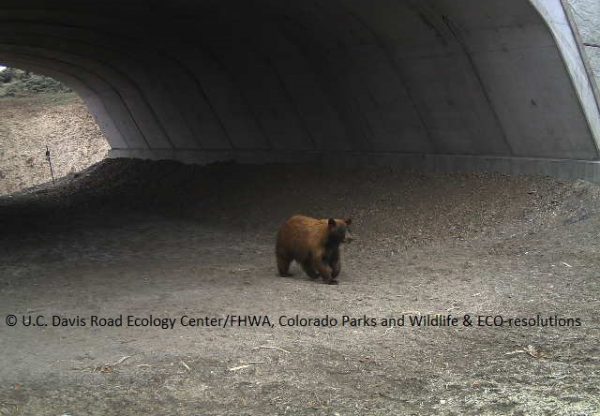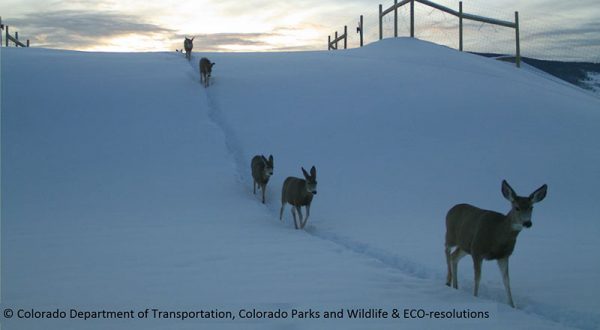Colorado’s rapid population growth affects wildlife by reducing habitat and bringing them in closer contact with humans. Vehicle collisions are a serious threat to wildlife, and many roadways cross through the migration routes used by big game. To help protect wildlife – and motorists – from vehicle collisions, Colorado Parks and Wildlife (CPW) and the Colorado Department of Transportation (CDOT) have teamed up to study and provide safe crossings for Colorado wildlife.
 State Highway CO 9 between Kremmling and Silverthorne is an example of a successful wildlife crossing zone. Used by mule deer, elk, moose, bear, and even smaller wildlife like rabbits and skunks, the zone provides wildlife with opportunities to cross over or under the highway. The system also includes 20 miles of wildlife fencing to guide the wildlife to the seven crossings, along with wildlife escape ramps. “This innovative solution to keeping wildlife off a busy road resulted in a 90 percent reduction in wildlife-vehicle collisions in the first year,” reports CPW. Visit their website for more on the project, including a map, videos, and a slideshow of animals using the over- and underpasses. Additional information can also be found on CDOT’s website.
State Highway CO 9 between Kremmling and Silverthorne is an example of a successful wildlife crossing zone. Used by mule deer, elk, moose, bear, and even smaller wildlife like rabbits and skunks, the zone provides wildlife with opportunities to cross over or under the highway. The system also includes 20 miles of wildlife fencing to guide the wildlife to the seven crossings, along with wildlife escape ramps. “This innovative solution to keeping wildlife off a busy road resulted in a 90 percent reduction in wildlife-vehicle collisions in the first year,” reports CPW. Visit their website for more on the project, including a map, videos, and a slideshow of animals using the over- and underpasses. Additional information can also be found on CDOT’s website.
In 2018, CDOT, CPW, and other partners formed the The Colorado Wildlife and Transportation Alliance to bring awareness to the need for wildlife crossings and other conservation measures. And, this summer, Governor Polis signed an Executive Order requiring CDOT and CPW to enter into a Memorandum of Understanding to “identify priority areas for the implementation of big game crossings over and under roadways in Colorado.” The Executive Order further directs each agency to continue to study the issue. CPW is required to produce two reports of recommendations, and CDOT must “incorporate consideration of big game migration into all levels of its planning process, to the greatest extent possible.” For additional information on wildlife crossings, see the following publications:
- Fencing with Wildlife in Mind (CPW)
- Identifying the Best Locations Along Highways to Provide Safe Crossing Opportunities for Wildlife (CDOT)
- Roads and Connectivity in Colorado: Animal-Vehicle Collisions, Wildlife Mitigation Structures, and Lynx-Roadway Interactions (CDOT)
- State Highway 9 Wildlife Crossings Monitoring Annual Report year 1, year 2, year 3 (CDOT)
- Western Slope Wildlife Prioritization Study (CDOT)

- How to Spot the Differences Between Eagles and Hawks - August 16, 2021
- How Transportation Projects Help Tell the Story of Colorado’s Past - August 9, 2021
- Time Machine Tuesday: The Night the Castlewood Canyon Dam Gave Way - August 3, 2021
Please add Pagosa Springs to this study!!! We have been trying to get CDot approval for two deer signs in downtown Pagosa Springs for years. We were told that there were not enough “strikes” within a mile of our location within a year. While that may seem like good news, the scary part is that we can have as few as one deer, and as many as twenty trying to cross US Hwy 160. Most of the crossing comes between 4 and 6 when the sun is starting to set and shining right into the eyes of drivers. We understand we live in a mountain town, and there is going to be wildlife. Visitors, or people just driving through; however, do not know to watch for a herd of deer crossing a US Hwy. If needed, we would be happy to point out a few power-poles currently without signs, that would be a great place for a deer crossing sign.